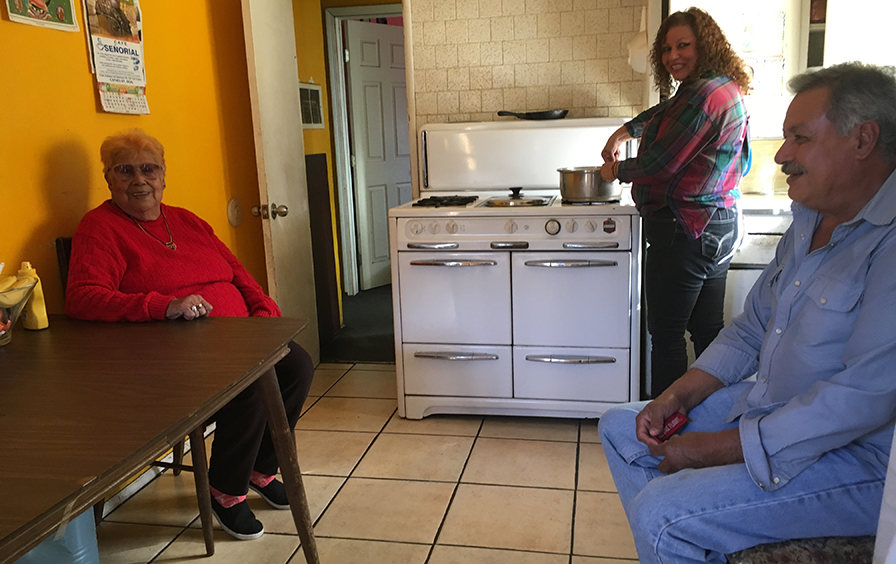The family had lived in their El Sereno home for 25 years when they were told they’d have to move. The building had been sold. The new owner wanted them out, and planned to triple the rent.
“We were in shock,” said Sandra Sutan, 51, who pays $600 a month for the cramped two-bedroom cottage, shared with her son, brother, nephew and elderly mom. “We tried to look for a place,” she said, but even a basic one-bedroom cost more than the family could afford.
“I was so afraid, I couldn’t sleep,” said Sutan’s mother, Aurelia Irigoyen, 81. For her, the tiny home is crammed with precious memories. She recalls walking her youngest son—now a Navy officer—to Huntington Drive Elementary, just down the street.
“I worried that we’d be out on the street; that we’d wind up homeless,” she said.
Instead, the family reached out to the Inner City Law Center, which challenged the rent hike and eviction in court and won a jury verdict.
The family stayed put. And the campaign to prevent homelessness scored another success.
A prevention program launched last year by Los Angeles County and its social service partners is a linchpin in county efforts to combat homelessness.
The project provides short-term financial support for vulnerable families, incentives for landlords willing to rent to them, and legal assistance for families threatened with eviction. More than 340 families have received prevention services, and 160 were helped to remain in their homes.
These are families that don’t show up in official homeless counts, but are often just “one bad week away” from landing on the streets, said Dan Parziale of LA Family Housing in North Hollywood.
Some are bunking with friends, staying in cheap motels or doubling up with relatives because they can’t afford the upfront costs of moving into an apartment. Others have apartments but are on the verge of being evicted.
“They tend to be working and have decent income,” Parziale said. “But they don’t have the resources to bounce back from a car repair or medical bill or the loss of a job. That cuts into the money they need for rent.”
Evictions are hard to challenge in court, said attorney Jennifer Ganata of the Inner City Law Center, which helped the Sutan family under the auspices of the Shriver Project, which provides legal representation to low-income families.
Now the Inner City Law Center is part of the county effort, with a contract to provide legal services to residents facing eviction. Because without legal help, Ganata said, “it is almost guaranteed that the family will lose … even if they have the law on their side. This then sets the family up for a downward spiral into homelessness.”
It often takes only a few thousand dollars to get or keep a family housed until they get back on their feet. That’s more cost-efficient than motels or shelter beds.
In fact, prevention is considered the key to reducing the ranks of homeless families, particularly in a rental market as tight and unforgiving as Los Angeles County, where the glut of applicants and shortage of affordable spots means landlords can be quick to evict and picky about new tenants.
“It’s a lot harder now for families that used to be able to make it month-to-month,” Parziale said. “Landlords don’t have to be as flexible as they were in the past.
“But if we can step in and stop the homeless experience before it takes place, that means kids can stay in their schools and the family is not so stressed.”
Los Angeles County and its partners are determined to enlist as many landlords as possible as allies in the fight against homelessness.
“We have a team that spends all day, every day trying to build relationships with landlords,” said Parziale, whose agency has helped the county house scores of families.
More than 200 landlords turned out at a recent recruitment fair in Hollywood to learn about programs that cover move-in fees, pay landlords to hold apartments open for tenants who have vouchers and subsidies, and offer financial help for tenants who are behind on their rent and might wind up on the street.
The group heard promises of help from local officials and a plea from a mother of three, who was able to keep her family together, enroll in college and find a stable job because a landlord agreed to rent her a Koreatown apartment.
“My life, it took off after that. All I needed was a home,” Amiyoko Shabazz told the crowd. “So I’m asking you to take a chance. We have a crisis, an epidemic. We have a duty to be part of the solution.”
Landlord Abraham Kohen shared what it’s like to be part of the solution.
He’d always been leery of dealing with government programs; property owners shy away because they’re worried about paperwork and inspections.
But after a well-heeled tenant stiffed Kohen for several months’ rent on a five-bedroom house he owned, he agreed to accept a rent voucher from a military veteran.
That tenant took good care of home and the rent was always on time. “But forget about the monetary stuff,” Kohen told his fellow landlords.
There is more at stake than the bottom line.
“When I gave them the keys and I saw that family tear up in front of me, I knew I’d done the right thing,” he said. “And I made a commitment that I will do this again.”
To learn more about L.A. County efforts to prevent and reduce homelessness, go to homeless.lacounty.gov.


